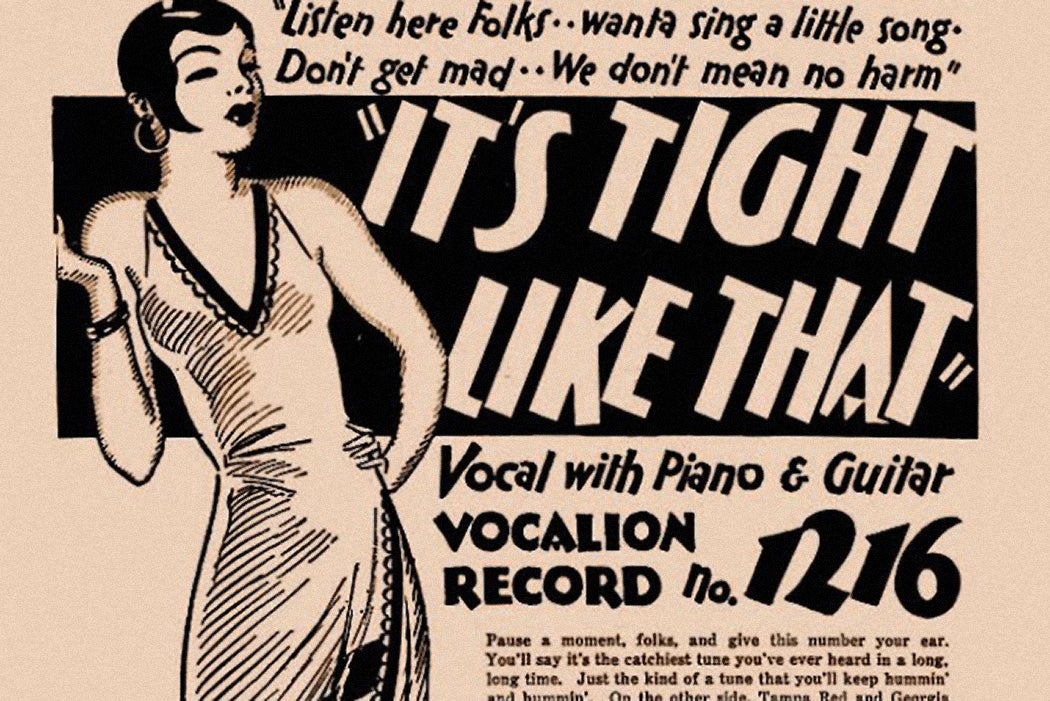“Never have there been as many dirty blues records on sale as today,” begins a 1952 Jet Magazine article. Songs like “60-Minute Man,” “Lollipop Mama,” and “Long John Blues,” with their sly double-entendres may have been cleverly written, but “by cunning inflections and constant usage, such words as ‘rocking,’ ‘roll,’ ‘bite,’ ‘rider,’ ‘grind,’ and ‘grass’ have become standard dirty-record vocabulary.”
Some scholars also had a problem with this music. As musicologist Roberta Freund Schwartz explains, since the 1940s, many have argued that “little of this…music is worth serious consideration.” For those listeners, it represented “a degradation of the robust folk blues into ‘glossy, mechanistic self-parody and tasteless double-entendre.’”
This type of blues, however, has a long tradition. It came to be known as “hokum” blues, Schwartz explains, and it had a formula: “humorous and suggestive lyrics, moderate to fast tempos, dance rhythms, and evocations of both rural and urban styles of African American music, usually in twelve-bar verse and refrain form,” with roots in vaudeville and even earlier. For example, the 1920s song “I Want a Hot Dog for My Roll” was considered so raunchy that the label refused to release it. But a specific song, Schwartz writes, “is often identified as the root cause of this ‘corruption’”: “It’s Tight Like That,” recorded by Thomas A. Dorsey and Tampa Red in 1928.
For gospel fans, one of the those names may seem out-of-place—that of Thomas Dorsey. Often credited as the father of gospel music, it’s hard to imagine that the same person who wrote “Walk Over God’s Heaven” and “Take My Hand, Precious Lord” was a part of this movement, but we all contain multitudes. One of the many layers of Dorsey’s life was as a piano player at juke joints in Atlanta. He also worked as blues singer Ma Rainey’s bandleader, a composer, and a vocal coach at Paramount Records.. Some of these jobs were performed under the pseudonym Georgia Tom. “It’s Tight Like That” certainly was. Hudson Whittaker, aka Tampa Red, was newer to the business, but Dorsey thought it was a “really rewarding association.” They teamed up, playing at house parties and speakeasies.
Weekly Newsletter
These parties moved from house to house, venue to venue, and the people needed something to dance to, a “blues suitable for the popular dances among Chicago’s [B]lack population: the stomp, shimmy, black bottom, and scraunch.” And if it was popular in the clubs and parties, it could be popular on records. At least that’s what the people at Paramount Records thought. Tampa Red had a meeting with the label, but to record, he needed an original song. He went to Dorsey’s place, and the pair tried to work something out, anything, just one song. And as Red recalled, one of the slang phrases that echoed through the city streets was “It’s tight like that.”
And the rest, as they say, is history.
The label loved it. The people loved it. And yes, it was very suggestive. One of the phrases in the song, “beedle-um-bum,” was slang that had been used in earlier songs. As Dorsey explained, “The gals would sing those kind of suggestive words while dancing around with their fellows.” And for listeners in 1928, its use indicated that it was a “dirty” song. Within three weeks of its release, there were already cover versions, with dozens more released over the years. Even the clergy joined in: Reverend J. M. Gates recorded “These Hard Times are Tight Like That” in 1930.
The song “marked the beginning of the commercial hokum blues craze,” Schwartz writes. For Dorsey and Red, it was just another day, just another song. As Dorsey put it, “It was just something that popped up at the right time, to make some money. It still goes!”







